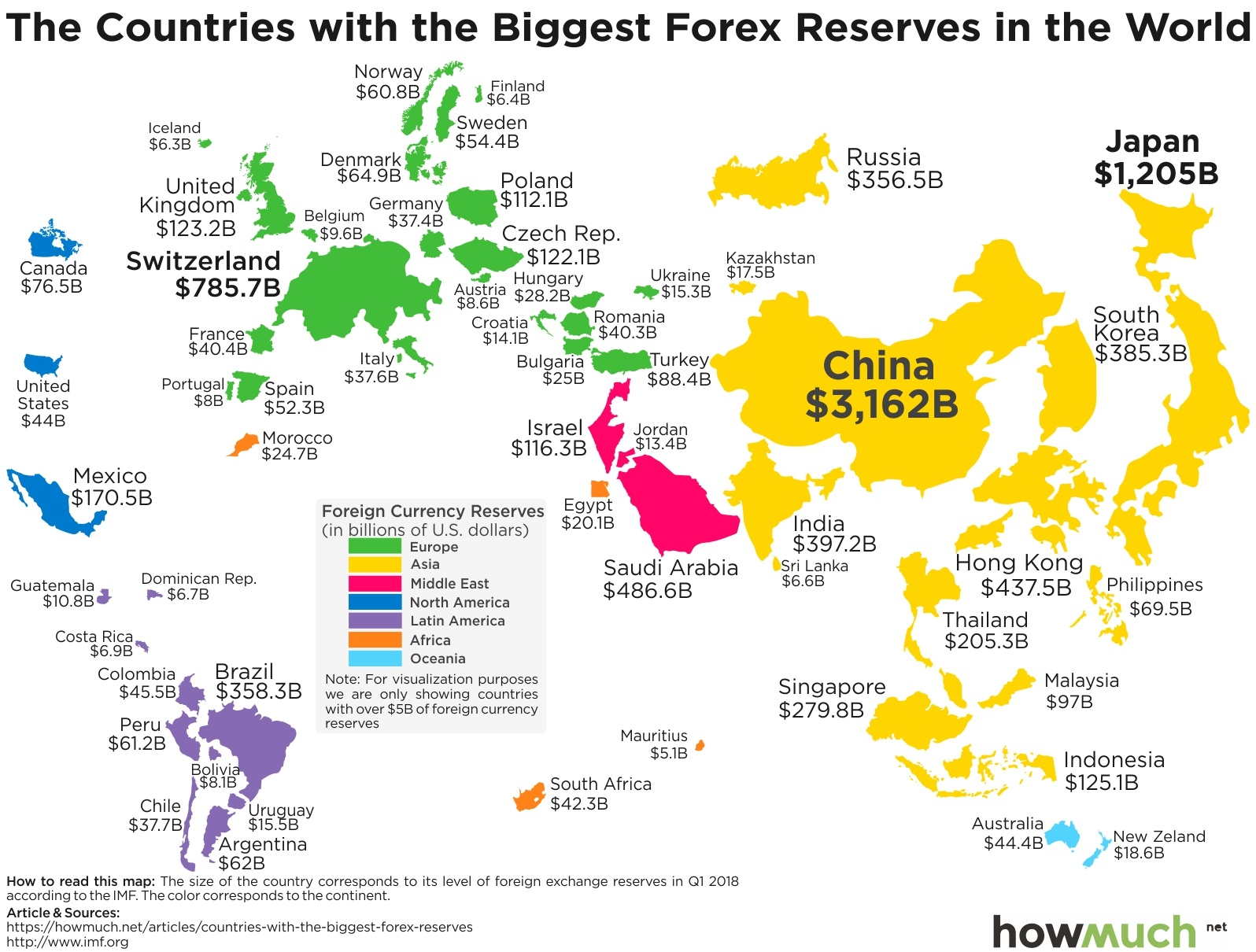Foreign exchange (or forex) reserves are a key indicator of economic health. They provide policymakers with a tool to control inflation, ensure the continual flow of imported goods into the country, and generally provide a sense of security in uncertain economic climates. With the U.S. national debt recently topping an eye-popping $21T, we started thinking about how the U.S. stacks up against the rest of the world in forex reserves.
 We got our data from the International Monetary Fund (IMF) for Q1 2018 (the latest numbers for a handful of countries, like Saudi Arabia, are from 2017). We first color-coded each country by continent and then adjusted the size of the country by its reserves, excluding those places with less than $5 billion in reserves. This approach provides a unique snapshot of the world economy in one easy-to-understand and colorful map.
We got our data from the International Monetary Fund (IMF) for Q1 2018 (the latest numbers for a handful of countries, like Saudi Arabia, are from 2017). We first color-coded each country by continent and then adjusted the size of the country by its reserves, excluding those places with less than $5 billion in reserves. This approach provides a unique snapshot of the world economy in one easy-to-understand and colorful map.
Top 10 Countries with the Biggest Forex Reserves
1. China: $3,162B
2. Japan: $1,205B
3. Switzerland: $785.7B
4. Saudi Arabia: $486.6B
5. Hong Kong: $437.5B
6. India: $397.2B
7. South Korea: $385.3B
8. Brazil: $358.3B
9. Russia: $356.5B
10. Singapore: $279.8B
The first and most obvious trend on our map is the uneven distribution of forex reserves around the world. China leads by a longshot with $3,162B, almost three times as much as second place Japan at $1,205B. It is hard to imagine just how much money China has stashed away—it’s enough to power the entire $2,651B economy of the United Kingdom for an entire year and then some, royal weddings included. Switzerland stands out in third place with $785.7B as the only European country in the top 10. Part of the explanation is that the Swiss opted out of the European Union, making the Swiss franc a safe haven for European investors. Our ranking becomes tighter further down the list with less separation between the countries, but suffice it to say forex reserves are top-heavy.
You can see the same top-heavy trend when looking at which continents have the highest reserves. Asia clearly leads the way on the right side of the map, second to the green countries from Europe (thanks only to Switzerland). Every other continent is comparably tiny. Take a look at North and South America compared to Asia. It’s not even close. And where is the entire continent of Africa in our visualization? Since we excluded countries with less than $5B in reserves, only four orange countries made it onto the map.
What does this say about the world’s economies? Countries that have a lot of exports tend to stockpile the most forex reserves. Think about all the goods that flow out of China, consumer electronics from Japan, and oil from Saudi Arabia. These places dominate in particular industries or sectors, making them a magnate for forex reserves. Having a large stash of foreign currency means that countries like China and Japan can better handle unexpected economic surprises. The United States only has $44B in forex reserves. That’s not necessarily a cause for alarm because many export-dependent countries rely on America to purchase their goods. That’s how they ended up with such large caches in the first place. Here’s to hoping that current trends continue long into the future.
Data: Table 1.1
About the article
Authors
Irena - Editor





